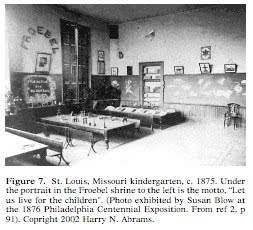
A few years ago I was visiting a class at ESSA in which old pages torn from books were being used in art projects, and I found one page that grabbed my attention. It was about kindergarten and had a printed guide to paper folding, so I kept it as a book mark in one of my other early texts. I have been curious about its source. While I still don't know the name of the book from which it came, I did find a duplicate of the printed text on-line, as A list of Home Occupations for Children.
The keynotes of the kindergarten handwork are two: expression, or "self-expression" as it is generally called, and development, or step-by-step progress, from easy to difficult, from simple to advanced, from familiar to new work. That is, the child has many sides of his nature which need other expression than words, and many ideas, especially the germs of artistic ones, which he could not put into words. He can, through his power of "creating," express them by materials. He has a chance to express, to clinch the perceptions of color, contrast, etc., which are awakened by the experiments with the gifts; and he expresses, besides, all his childish delight in nature and life, by trying to make the objects he sees about him. Froebel tried to provide a large range of materials, which covered many degrees of resistance, flexibility, or plasticity, so that a fairly complete set of life experiences might be expressed: string, clay, sand, chalk, seeds, worsted, paper, cardboard, peas with sticks, wooden slats, etc. A teacher uses these in a more systematic way than they can be used at home. The aim of home work is to use a variety of materials, so that the children can soon learn to employ themselves independently, and be happy in it; and to work, in some degree, from easier to more difficult things.Parents, these days are intent on spending money for technology to allow their children to keep up with the Joneses or the Chinese, depending on their particular argument of choice. Far better would be an investment in scissors and string. For this greater investment, at much less cost, the guide page I found torn from a book is a treasure. Use the link to gain access to parental wisdom often lacking in modern society. The image above is from my torn page showing a guide to paper folding techniques similar to Paper Sloyd.







































